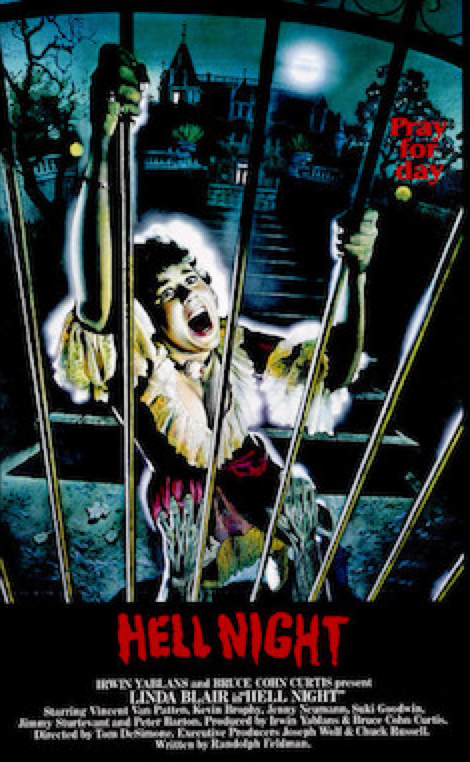Why the ‘80s were the best years of film restoration
This ‘80s theatrical poster is enough to give anyone the chills.
March 22, 2019
On Friday, I put in my new Blu-Ray for the 1981 slasher movie Hell Night. I was expecting a nice cheesy slasher movie experience that only the eighties could give (and on that front, it succeeded extremely well), but one thing I didn’t expect was a message before the movie started stating:
“We did an extensive search for the original film elements, but were unable to locate them. Therefore, this new transfer comes from a 4K scan of the best surviving archival 35mm film print of Hell Night. We did extensive color correction and film restoration to clean up any film damage. Because the print was missing some minor footage, so we have inserted a small amount of standard definition footage to deliver the complete film. We hope you enjoy this new restoration of this ‘80s horror classic.”
In essence, the people who made the Blu-Ray (aka Shout Factory), couldn’t get the original film for he movie, and had to use a preexisting print for their release.
This was evident while watching, especially when compared to their other releases such as their beautiful release of John Carpender’s The Thing. For starters, the picture quality is not nearly as clear as The Thing Blu-Ray. There are far more film scratches and blips, the color is not nearly as sharp, and there are many jarring cuts where the put the additional SD print in between the stretches of archival print footage.
This is especially egregious in one scene where a character is looking over his head, and the film has a red tint to it for about ten seconds. While these could be chalked up to a bad job at cleaning up the print, it is a bit more complicated than that.
To reiterate, the original film elements were missing. What they are referring too are the pieces of film the movie itself was shot on, which if most often sought after due to it capturing the highest quality images for a movie, due to being an analog medium.
Normally, after acquiring some of the original prints, there would be extensive repairs to the prints themselves, often by repairing scratches, dirt and dust, and film tears. Restoration processes such as color fade, excessive grain, and film cell shrinkage are done using digital computers.
These are accomplished by use of color correction, contrast, and my remastering the movies audio. After that, the computers also scan the film to put into the highest resolution possible, often a 4K resolution for modern releases. Once the manual and digital touch ups are done, it is put onto DVD or Blu-Ray disks and sent out to stores and online retailers.
In the case of Hell Night, the original negatives were lost, destroyed, or otherwise missing, forcing them to use the aforementioned archival print as their base, with the SD print being used to fill in gaps in the archival prints footage. And while extensive working with archive prints can still have good results, there is still only so much you can do.
In this case, they could not fix the prints as much as their other releases showed they could, as there was too much damage on what was available, making this Blu-Ray the best Hell Night will most likely ever be until a better print or the negatives are found, made less likely due to the fact that Hell Night, while not exactly unpopular, did not have box office success that prompted many people to keep the negative, or gain a large post-box office following the likes of The Thing or Killer Klowns From Outer Space, where major interest caused the negatives to be kept, or led to searched where they (or high quality prints) were found.
All things considered, though, Hell Night was lucky it came out when it did. Hell Night was released in 1981, the same decade film restoration and preservation became major focus for the film industry due to it being apparent that old film prints were decaying. Before then, films were preserved, but not restored, and preservation itself did not start until the fifties.
In fact, it is believed that 50 percent of sound film made before the fifties are lost, and 90 percent of all silent film are lost as well, and that’s just in America. Places with worse infrastructure or places that were ravaged by war often have their entire pre-fifties libraries wiped out.
Being released in the eighties made it almost guaranteed that someone would grab a print for the purpose of keeping the movie alive, even if it was a pretty average movie. If it came out three, two, or even a single decade before it did, it could very well have been lost, or at least left in an even more unpolished state, like many films of its time. It shows how far preservation had gone, and how the technology to keep movies alive has preserved decades of otherwise lost material.
Many of the most iconic movies ever, such as Nosferatu and The Phantom Of The Opera, would have either been lost or ruined if not for modern techniques.
For more information of film restoration, I would recommend the article How Criterion Collection Brings Movie Back From The Dead, along with its accompanying video to get a better idea of the film restoration process.








